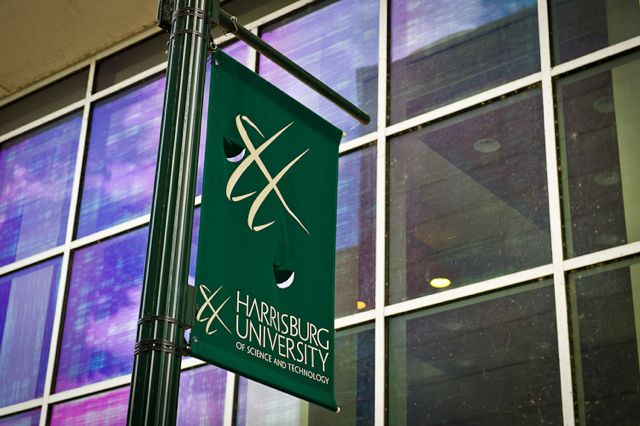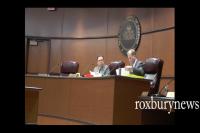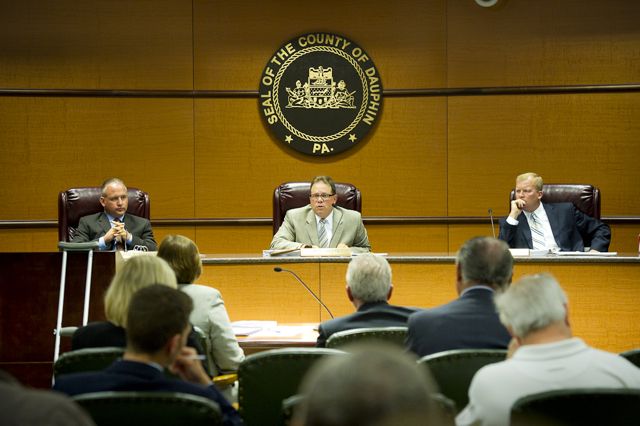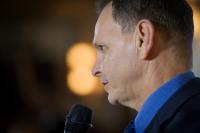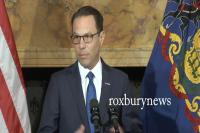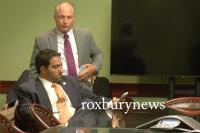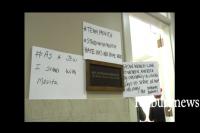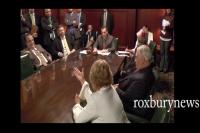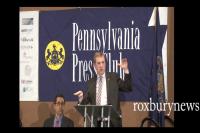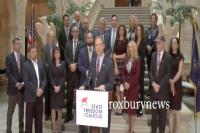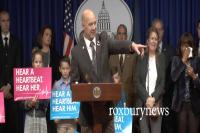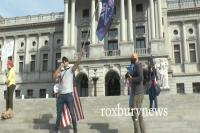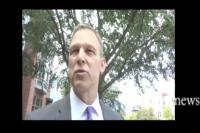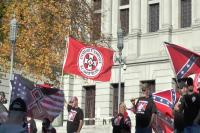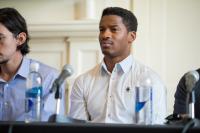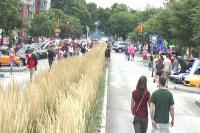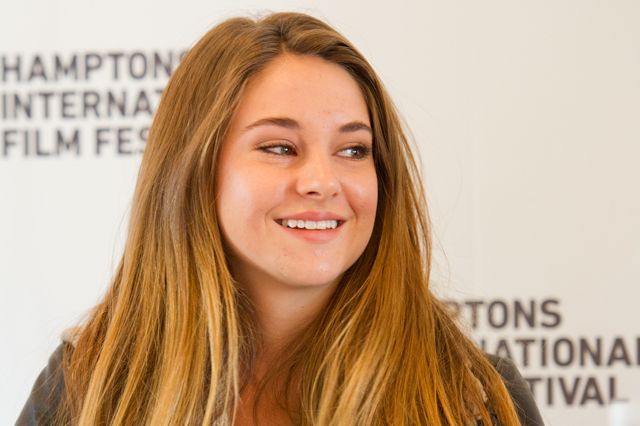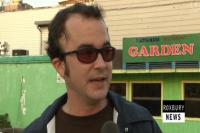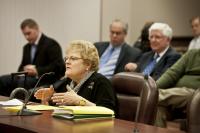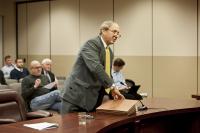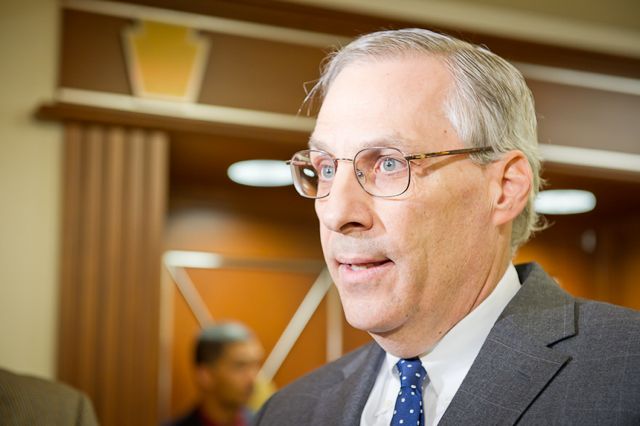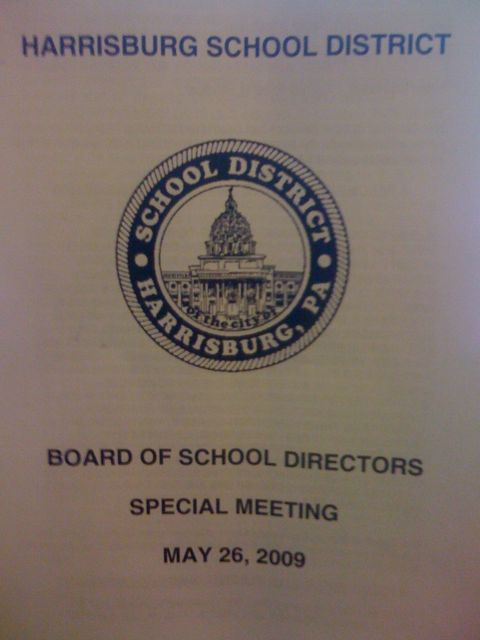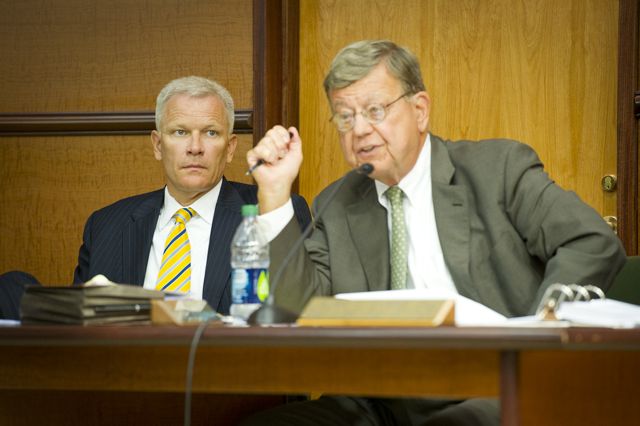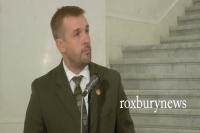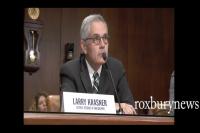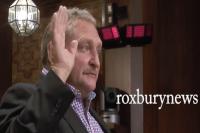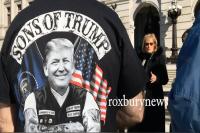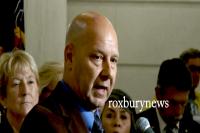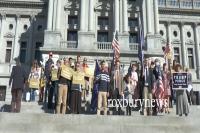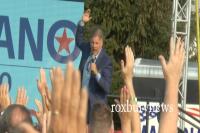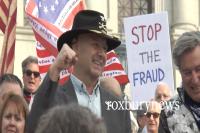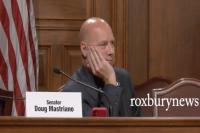Captain Gabriel Olivera of the Harrisburg police department held a press event Wednesday afternoon to provide information of the Sunday morning burglary of the National Civil War Museum.
The guns were part of the NRA sponsored Guns and Lace exhibit.
Wayne E. Motts, CEO of the National Civil War Museum describes guns stolen from the museum February 14, 2016.
Photo slideshow of the stolen guns.
__________________________
60 F. Supp. 2d 450 (1999)
George E. PICKETT V v. AMERICAN ORDNANCE PRESERVATION ASSOCIATION, et al.
No. CIV. A. 98-3460.
United States District Court, E.D. Pennsylvania.
August 24, 1999.
*451 Gavin P. Lentz, Bochetto & Lentz, P.C., Stephen E. Skovron, Bochetto & Lentz, P.C., Philadelphia, PA, for George E. Pickett, V, Plaintiff.
Emanuel Kapelsohn, Blank Rome Comisky & Mccauley LLP, Allentown, Jeffrey B. Mc Carron, Anthony T. Febbo, Swartz, Campbell & Detweiler, Philadelphia, for American Ordnance Preservation Association, Russ Pritchard, III, City of Harrisburg, PA, Defendants.
MEMORANDUM
BARTLE, District Judge.
In the mid-afternoon of July 3, 1863, over 10,000 soldiers under the command of Confederate Major General George E. Pickett advanced eastward across open fields at Gettysburg, Pennsylvania toward the center of the Union line which was concentrated on a rise known as Cemetery Ridge. What has come to be called Pickett's Charge ended disastrously for the men in gray.[1] Their frontal attack was decisively repulsed. More than half of those Southern soldiers fell, either killed or wounded. The next day, the defeated Army of Northern Virginia retreated southward toward the Potomac and beyond. That battle, it is generally acknowledged, marked the turning point in the Civil War and the beginning of the end for the Confederacy.
Because of that fateful charge at Gettysburg long ago, a charge which lasted less than an hour, history remembers General George E. Pickett. And because the Muse remembers him, there is today a market for his memorabilia. This brings us to the current battle, which is being waged in the legal rather than the martial arena. This time there is a charge of fraud.
I.
This diversity action involves memorabilia of General Pickett sold by his direct descendant, the plaintiff George E. Pickett V ("Pickett"), to defendants, the American Ordnance Preservation Association ("AOPA") and Russ Pritchard, III ("Pritchard"), a co-owner of AOPA.[2] The plaintiff claimed that these defendants defrauded him. The jury agreed and returned a verdict in his favor. Judgment was entered for Pickett in the amount of $806,140.[3] Following this setback, defendants have now fired another salvo. Before us is the motion of the defendants for judgment as a matter of law or, in the *452 alternative, for a new trial on his common law fraud claim. See Fed.R.Civ.P. 50(b).
We view the record in the light most favorable to the plaintiff, the verdict winner. Simone v. Golden Nugget Hotel & Casino, 844 F.2d 1031, 1034 (3d Cir. 1988). Pickett's mother had given him some of General Pickett's effects as gifts throughout his childhood. Nonetheless, they always remained in a trunk in his mother's house until she went to live in a nursing home. Pickett had not taken any particular interest in them, had never had them appraised, and had not considered selling them. Indeed, Pickett did not really know exactly what items of his ancestor he possessed until defendant Pritchard appeared on the scene.
The AOPA, of which Pritchard was co-owner, was in the business of dealing in and appraising 18th and 19th century military items. It also served as a consultant to various museums and libraries. Pritchard had heard rumors that some of General Pickett's effects related to the Civil War still remained in the Pickett family. In September, 1995, Pritchard called Pickett at his home in Wilmington, North Carolina to discuss whether he could examine and purchase whatever artifacts of General Pickett he had. Pritchard explained that he was acting on behalf of the City of Harrisburg which wanted such items for display in a Civil War museum the City was constructing. Pritchard mailed Pickett a letter signed by Harrisburg Mayor Stephen Reed that began, "[t]his serves to formally introduce Mr. Russell A. Pritchard, III, of the American Ordnance Preservation Association. He is acting as an official representative of the City of Harrisburg in his discussions with you." (Ex. P-4). It went on to describe the museum as a publicly owned, non-profit institution which will be a "significant public education center" and "will attract national attention." According to the letter, the museum hoped to acquire General Pickett's artifacts because "[i]t is our view that General Pickett has not been accorded his due in how history is today presented. We plan to change this." Finally, the letter assured Pickett that "Mr. Pritchard has an extensive background in matters related to Civil War artifacts and has distinguished himself in the field through his research and acquisition activities." Without the representations made in the letter from Mayor Reed, Pickett testified he would not have met with Pritchard or sold him the artifacts.
Pritchard traveled three times in the fall of 1995 from Pennsylvania to North Carolina to see Pickett with the aim of examining and purchasing General Pickett's memorabilia.[4] He took Pickett and his family to lunch on September 23, visited the Picketts again for several days in early October, and returned a final time on October 25. Among other activities, Pritchard attended a surfing contest in which Mrs. Pickett participated, spent the day at a construction site where Pickett was working, and joined Pickett at his yoga class.
Pickett did not exhibit any of his ancestor's possessions to Pritchard on his first visit. However, on October 10, 1995, during the second visit, Pickett did so. As Pritchard and Pickett were viewing the items that evening, Pritchard explained what each one was, listed the artifacts on a piece of paper, and assigned values to them. He told Pickett he was doing an appraisal of the artifacts and that some items, such as the General's kepi (cap) and sash, had increased worth because they belonged to the General. Pritchard was discriminating; he bought some items and not others. Pritchard purchased General Pickett's kepi, a uniform sleeve (purportedly containing a hole from a bullet wound the General had received at the Battle of Gaines Mill), special sleeve wraps, a sash, *453 wedding shoes, three of the General's military appointment papers from the Confederate Government, General Pickett's portrait, a map of Gettysburg, a notebook he had kept during his days as a student at West Point, three letters, and a lock of hair, all in exchange for $62,000$5,000 in cash and $57,000 by checkand a promise to deliver a computer to Pickett in the future.
Pritchard returned to North Carolina on October 25 for his third and last visit. On this occasion, he purchased letters and other documents of General Pickett that he selected from the numerous papers in the trunk. Pritchard paid Pickett $16,000 in cash. A receipt signed by Pickett and Pritchard lists the purchase price for the documents and provides that Pickett has "retained copies and publication rights of all papers and documents and images in this and in previous group for the benefit of my children." As part of the consideration, Pritchard also agreed to fund a vacation for the Pickett family in Costa Rica, and promised to supply Pickett with a copier. Pritchard reimbursed Pickett $10,800 for the trip.
Among the items not purchased by Pritchard were family photographs and an image of Confederate General James Longstreet. When Pickett informed Pritchard that he did not want to sell the photographs, Pritchard offered to have them restored and framed for Pickett at no cost.
Only a few weeks after the purchases, and unbeknown to Pickett, Pritchard sold the artifacts to the City of Harrisburg for the princely sum of $880,000, after having paid Pickett only $88,800.[5]
During their discussions in North Carolina, Pritchard had continually represented to Pickett that the prices he was paying were all that the items were worth. For example, on one occasion, after Pritchard had set the purchase price, Pickett inquired "is this all that these are worth, is this the best price, the most value that these are worth?" (6/4/99 Tr. at p. 18). According to Pickett, Pritchard told him that
[h]e had to be fair to the mayor, he had to be fair to the city. He could not overappraise it. The most he could fudge it by was just a little bit .... He pulled out this cash and laid it on the table and said, he said, that's the best I can do, he said that's the most I can fudge this appraisal. And I said, okay, it's going to the museum. (6/4/99 Tr. at p. 19). * * * * * * He told me that this was all that the items were worth and that he had inflated the appraisal as much as he possibly could. (6/7/99 Tr. at p. 152). [Emphasis added]. See, e.g., (6/7/99 Tr. at pp. 132, 151-52). Furthermore, Pritchard dissuaded plaintiff from selling the artifacts at an auction house by advising him that "the dealers would collude ... that they would ... get together and cheat about holding the prices down ...." (6/4/99 Tr. at p. 32). Pickett had a strong desire to have the collection go to a museum for the public to view. He did not want it split up among private investors. Pritchard played to this feeling because of his relationship with the City of Harrisburg.
Pickett received more money from these transactions than he earned in an entire year. He "had no idea" the artifacts were worth substantially more than Pritchard offered. (6/4/99 Tr. at p. 22). On cross-examination, Pickett testified that,
I trusted Russ Pritchard, he was representing the museum. I believed that *454 the museum had a ... vested right ... to appraise things at a fair market value and offer a fair market value. I had no idea that the mayor of the City of Harrisburg and the National Civil War Museum at the City of Harrisburg would send Russ Pritchard down to my house to defraud me of these items, I had no it never crossed my mind that that would happen, and that is in fact what happened. (6/7/99 Tr. at pp. 122-23). Pickett did not learn about the price paid by the City of Harrisburg until June, 1998 when he attended a dinner at Gettysburg given by the "Friends of the National Park of Gettysburg." This incidently was the first time Pickett had traveled to the battlefield area since he had once visited it as a child. As one of the guests of honor at the dinner, he was seated at a table with Earl Coates, the president of the organization. In the midst of their conversation, Pickett asked Coates out of the blue how much a kepi of General Pickett might be worth. Coates mentioned a sum that exceeded the amount Pickett had received from Pritchard for all of the items put together. Later that weekend, Coates took Pickett to a Civil War dealer in Gettysburg. At that time, Pickett first discovered that the photographs restored and framed by Pritchard, which Pickett had brought with him for a talk he gave, were not the originals as promised, but were laser copies. Coates also found out and disclosed to him approximately what the City of Harrisburg had expended for the Pickett collection. As had happened with his namesake over a century before, a turn of events at Gettysburg thrust Pickett into a gray state. This time it triggered a lawsuit.
II.
Defendants first advance the position that we should grant their motion for judgment as a matter of law on plaintiff's common law fraud claim on the ground that it is time barred. The parties do not dispute that the Pennsylvania two-year statute of limitations for fraud is applicable. See 42 Pa. Cons.Stat. Ann. § 5524(7).
The fraud found by the jury occurred in October, 1995. This action, however, was not initiated until July 6, 1998, some two years and eight months later. Unless the statute is tolled, Pickett's fraud claim is out of time. Under Pennsylvania law, the "discovery rule applies ... when the underlying cause of action sounds in fraud and ... the statute of limitations is tolled until the plaintiff learns or reasonably should have learned through the exercise of due diligence of the existence of the claim." Beauty Time, Inc. v. Vu Skin Sys., Inc., 118 F.3d 140, 148 (3d Cir.1997). See also, Gee v. CBS, Inc., 471 F. Supp. 600 622-24 (E.D.Pa.) aff'd 612 F.2d 572 (3d Cir.1979).
As noted, Pickett did not become aware of his injury until he came to Gettysburg in June, 1998. Within less than a month, this action was filed. Accordingly, the relevant question is when Pickett reasonably should have learned of the fraud through the exercise of due diligence. Where the reasonableness of the delay in discovering one's injury is genuinely in dispute, it is a matter for the jury to decide. In Burnside v. Abbott Labs., 351 Pa.Super. 264, 505 A.2d 973, 988 (1985), the Superior Court of Pennsylvania held,
where the issue involves a factual determination regarding what is a reasonable period of time for a plaintiff to discover his injury and its cause, the determination is for the jury .... Only where the facts are undisputed and lead unerringly to the conclusion that the length of time it took the plaintiff to discover the injury or its cause was unreasonable may the question be decided as a matter of law .... Based on the evidence in the record, we believed the issue was one for the jury. Consequently, we included the following interrogatory on the verdict sheet: "Using reasonable diligence, could plaintiff have discovered the existence of the alleged fraud by Pritchard and the American Ordnance Preservation Association before July 5, 1996?" The jury answered "NO."
*455 The defendants do not contend that the form of the interrogatory was defective or that the language of the charge was in error. Rather, defendants assert the issue should not have been submitted to the jury but instead should have been decided by the court in their favor as a matter of law. We disagree.
The jury found by clear and convincing evidence that defendants Pritchard and the AOPA had committed fraud. Pritchard recognized he had a treasure in his grasp when he saw the Pickett collection. He was aware that its provenance or authenticity, often a major concern with Civil War artifacts, was unlikely to be a problem here because the items had remained intact in the Pickett family over the generations. Pritchard represented to Pickett that he was an expert appraiser and an adviser on Civil War artifacts to many distinguished institutions. In his conversations with Pickett, he disclosed his familiarity with General Pickett's war record in the Confederate Army. He discussed knowledgeably each item he pulled out of the trunk. Pritchard knew immediately what items to buy and what items to leave behind. He told Pickett that the memorabilia of General Pickett were only worth approximately $88,800 and no more, when Pritchard knew that was not true. All the experts who testified at the trial, both for plaintiff and for the defendants, agreed that the effects in issue had a value considerably in excess of the amount Pritchard paid Pickett.[6] Knowing the market value that these experts later confirmed, Pritchard sold the items to the City of Harrisburg for $880,000, an astounding profit of almost 1000%, shortly after he made the purchases from Pickett.
The defendants make much of the fact that Pickett and his wife were college graduates and thus should not have been deceived. This fact, however, is not controlling on the issue of fraud. Simply because one has advanced education does not mean one cannot be defrauded. Neither Pickett nor his wife had any expertise in or knowledge of the esoteric field of Civil War documents or other artifacts. There was an abundance of evidence that Pickett trusted and reasonably relied on Pritchard and his expertise. Pritchard sent him the letter on official City of Harrisburg letterhead, signed by the mayor, stating "Mr. Pritchard has an extensive background in matters related to Civil War artifacts and has distinguished himself in the field through his research and acquisition activities." Pritchard reinforced this image in his conversation and by corresponding with Pickett on AOPA letterhead which listed a plethora of notable museums and governmental entities to which AOPA served as a consultant. He convincingly discouraged Pickett from going to an auction house with his collection, where the truth probably would have come out. Pritchard also ingratiated himself with and befriended Pickett and his family conduct which was designed to enhance Pickett's trust in him.
Contrary to defendants' position, we do not believe that Pickett had a duty, as a matter of law, to obtain a second opinion on the value of what he owned before parting with it. Whether he should have done so was a jury issue. Needless to say, after he handed over his ancestor's effects to Pritchard in October, 1995, he was no longer in a position to have his own appraisal made. Similarly, it was for the jury to decide whether Pickett failed to exercise due diligence in not contacting the City of Harrisburg to verify what it paid or whether Pickett failed to exercise due diligence in simply relying on Pritchard's affirmative representations as a Civil War expert, the letters from Mayor Reed and on AOPA letterhead, and Pritchard's purported *456 friendship with him. We do know Pickett moved with alacrity once he actually learned of his injury. In any event, in the final analysis, it was for the jury to determine whether Pickett had slept too long on his rights. It found in his favor, a decision which we will not disturb.
Finally, defendants move for judgment as a matter of law or alternatively for a new trial on the common law fraud claim on the ground that the evidence was insufficient to support a jury finding in favor of Pickett. The court charged that the plaintiff had the burden of proving common law fraud by clear and convincing evidence. Mellon Bank Corp. v. First Union, 951 F.2d 1399, 1409 (3d Cir.1991). The defendants argue that Pickett's proof failed this test.
As defendants accurately point out, the testimony at the trial was conflicting. While Pickett and Pritchard had quite different recollections of what occurred, the trier of fact believed Pickett. There was more than enough evidence for the jury to find by the clear and convincing standard "(1) a misrepresentation, (2) a fraudulent utterance thereof, (3) an intention by the maker that the recipient will thereby be induced to act, (4) justifiable reliance by the recipient upon the misrepresentation, and (5) damage to the recipient as a proximate result." Id. at 1409. Thus, we will not enter judgment as a matter of law in favor of defendants. Alternatively, we decline to grant a new trial since the jury's verdict did not result in a miscarriage of justice, does not cry out to be overturned, and does not shock the conscience of the court. Williamson v. Consolidated Rail Corp., 926 F.2d 1344, 1353 (3d Cir.1991).
III.
The defendants' shots have missed the mark. The present George E. Pickett has prevailed. Accordingly, the motion of defendants for judgment as a matter of law or, in the alternative, for a new trial will be denied.
NOTES
[1] The decision to make the charge came from General Robert E. Lee.
[2] Pickett also brought a claim against the City of Harrisburg. He contended that he was entitled to the return of his ancestor's artifacts sold by Pritchard to the City on the ground that Pritchard was acting as its agent under apparent authority. The jury found for the City. The judgment in the City's favor is not being challenged.
[3] The jury awarded plaintiff $500,000 on his common law fraud claim and $100,000 on his claim under the North Carolina Unfair Competition Law. See N.C. Gen.Stat. § 75-1.1. Any damages awarded under this statute are automatically trebled. See N.C. Gen.Stat. § 75-16. Plaintiff also sued for breach of contract, the details of which are not relevant for present purposes. Before submitting the case to the jury, the parties agreed that any contract damages would be $6,140. The jury returned a verdict for plaintiff for breach of contract, and the court added the $6,140 to the judgment. The portion of the judgment related to the North Carolina Unfair Competition Law and the breach of contract claim is not being contested.
[4] Pritchard made an earlier trip to North Carolina during which he attempted without success to see Pickett's mother in a nursing home. However, he did meet with Pickett's sister on that visit. While Pickett's sister put Pritchard in contact with Pickett, Pritchard did not see him on that occasion.
[5] Harrisburg Mayor Stephen Reed, testifying by videotape at trial, also told the jury that he was surprised to discover that Pickett did not receive most of the money the City had paid to AOPA. The Mayor, in a meeting with Pritchard, expressed his "astonishment that there was a 1,000 percent increase in between what was paid to Mr. Pickett and what we paid for the same artifacts and [let it be] known in fairly clear terms my displeasure at that fact." (Reed Dep. at p. 26).
[6] Plaintiff's expert Harry L. Rinker valued the total collection between $750,000 and $1 million while plaintiff's expert John Reznikoff testified it was worth between $800,000 and $1.5 million. Defendants' expert John Sexton valued the items at between $500,000 and $625,000, assuming all items were authentic and in good condition. Defendants' expert Steven Raab valued the documents in the collection at between $200,000 and $350,000.

